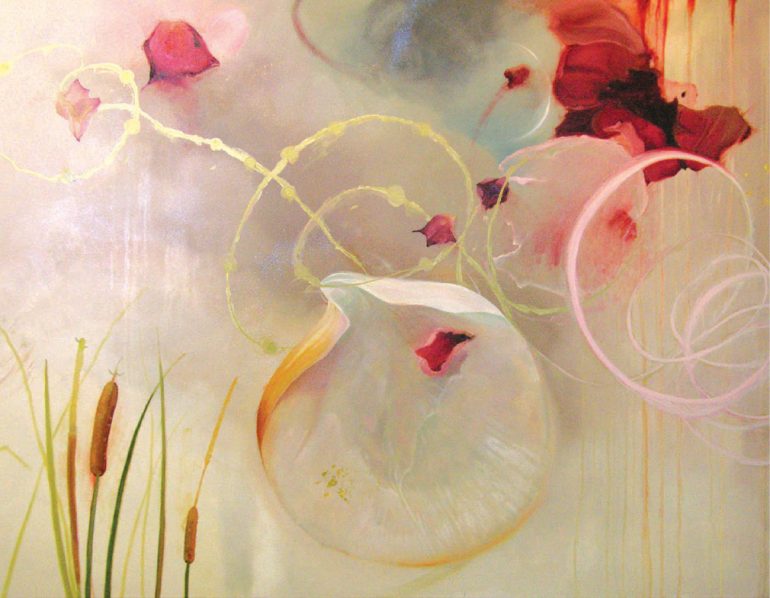“An idea that seemed to me to be of use to everyone — whether you think about it consciously or not — the idea of filling a space in a beautiful way.”
– Georgia O’Keeffe
Vaastu and the element of beauty in art
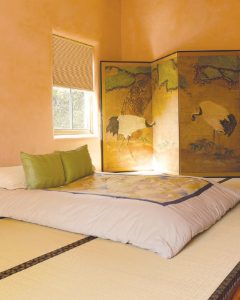 True Vaastu requires not only attunement with the laws of nature and the use of natural materials, but also beauty. Aesthetics are a major consideration: the site, the building, and its contents must be pleasing in its form and effect. All levels of life should be nourished: physical protection, emotional well-being, sensory and aesthetic satisfaction.
True Vaastu requires not only attunement with the laws of nature and the use of natural materials, but also beauty. Aesthetics are a major consideration: the site, the building, and its contents must be pleasing in its form and effect. All levels of life should be nourished: physical protection, emotional well-being, sensory and aesthetic satisfaction.
Here is an apt excerpt from the sacred Vaastu text Shilpa Vidya Rahasyopanishad:
“The space became decorated and beautified with stars and other luminous bodies. The Earth also became studded and decorated with mountains, forests, trees and so forth…”
Vaastu encourages you to imitate Nature and divine creation by beautifying your own spaces. This is a delightful concept: adorning your world with beauty makes your life more in harmony with nature. Keep this in mind when choosing artwork for your home, business, or any space where you spend time. Hearing beautiful sounds heals the ears. Seeing beauty heals the eyes. As writer Alice Walker puts it: “Whenever you are creating beauty around you, you are restoring your own soul.”
“What I dream of is an art of balance, of purity, of tranquility…a soothing, calming influence on the mind.”
-Henri Matisse
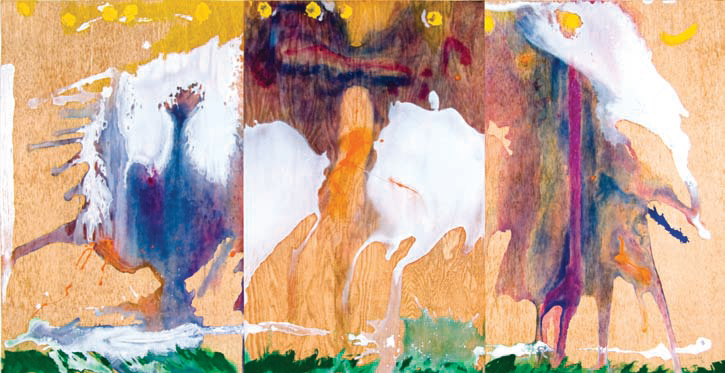
Image: Helen Frankenthaler, Book of Clouds, Aquatint, Etching, Woodcut & Pochoir with Hand Coloring.
Decorating is not just a matter of accumulating stuff; adorn your home with beauty that nourishes your soul. Choose your artwork and all your furnishings carefully. Only add items if you find them useful, beautiful, and comfortable. Adding ornamentation is an act of honoring. Ananda Coomaraswamy wrote: “The beauty of anything unadorned is not increased by ornament, but made more effective by it. . . . It is generally by means of what we now call its decoration that a thing is ritually transformed and made to function spiritually as well as physically.”
Remember that true Vaastu requires all levels to be fulfilled: functional space, aesthetics, spiritual energy, and upliftment of your soul. As my friends Ajit Mookerjee and Madhu Khanna wrote in The Tantric Way: “The beautiful and the spiritual form an inseparable whole. Beauty is a symbol of the divine.” The beauty we perceive with our senses is illuminated by the underlying radiance of the Absolute, the formless source of all existence and forms, which shines through the objects of this material world. Since Vaastu is a spiritually-based science, its foundation is this unbounded field of pure consciousness and eternal beauty.
Rasa: aesthetic juice
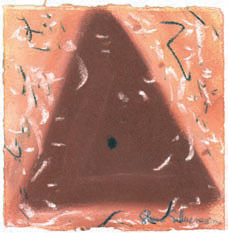 Great appreciation of beauty is a reflection of the beauty of your own inner nature. India scholar David Frawley writes, “Sundari shoots us with the arrows of delight, revealing all the forms of creation as aspects of our own blissful nature of pure consciousness.” Radiant works of art evoke in the refined viewer rasavadana, aesthetic experience. Indian aesthetics traditionally define beauty in terms of the effectiveness of the emotional impact of works of art; beauty is described in terms of rasa. Rasa is a Sanskrit term that translates as the juice or sap of a plant. In its use as a basic component of what is pleasing in the arts, architecture, and design, rasa refers to the juice or emotional flavor evoked by the experience of art. If something is juicy, it is full of that magical life-force energy that helps create the transcendental home.
Great appreciation of beauty is a reflection of the beauty of your own inner nature. India scholar David Frawley writes, “Sundari shoots us with the arrows of delight, revealing all the forms of creation as aspects of our own blissful nature of pure consciousness.” Radiant works of art evoke in the refined viewer rasavadana, aesthetic experience. Indian aesthetics traditionally define beauty in terms of the effectiveness of the emotional impact of works of art; beauty is described in terms of rasa. Rasa is a Sanskrit term that translates as the juice or sap of a plant. In its use as a basic component of what is pleasing in the arts, architecture, and design, rasa refers to the juice or emotional flavor evoked by the experience of art. If something is juicy, it is full of that magical life-force energy that helps create the transcendental home.
Image: Sherri Silverman. BMoCA #11: Nataraja, pastel painting on paper.
Traditionally there are nine major rasas, which are enumerated in the Vaastu Sutra Upanishad. Some rasas are appropriate for your home or office; some are not. Clearly, rasas of Shanta (peace, tranquility, serenity), Hasya (laughter, playfulness, good-natured humor), Vira (heroism), the uplifting aspects of Adbhuta (celestial joy, astonishment at the marvelous), and Shringara (romance, healthy eroticism, the blissful sweetness of love) can be appropriate for different zones of your home.
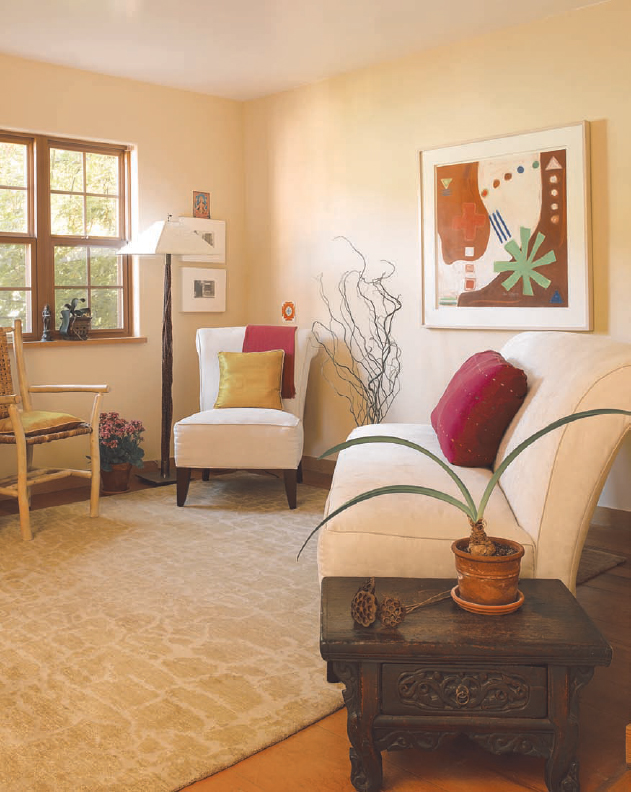
“Great art…is restorative…I believe that through our art, and through the projection of transcendent imagery, we can mend and heal the planet. ”
–Audrey Flack
The desire for serenity explains why so many people like to have Buddha statues in their homes, gardens, and offices. If you are evoking Shringara rasa in your home, make it the aspect of happy, united couples rather than the anguish of separation. Karuna (compassion), Raudra (anger, fury), Bhayanaka (fear), Bibhatsa (the odious), and other evocations of sorrow, despair, deprivation, anxiety, and disgust may be powerfully expressed through excellent art. However, unless they show the overcoming of these obstacles in an inspirational manner, they are not healing, nourishing influences in your home or office. What you put your attention on grows stronger in your life; you can choose between focusing on and increasing sadness, depression, and misery in your life, or you can make choices that help you become more established in peace and happiness.
Image: Pastel painting on wall: Sherri Silverman, Matthew #11.Photo: Erika Blumenfeld. Reprinted with permission of Gibbs Smith, Publisher, from Sherri Silverman’s Vastu: Transcendental Home Design in Harmony with Nature.
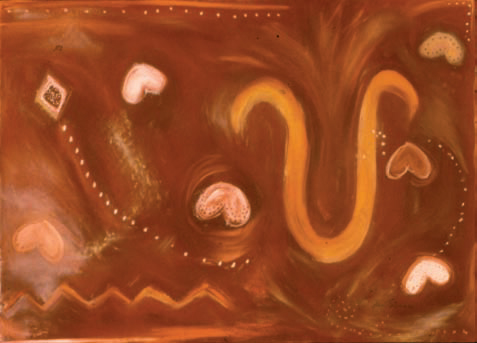 A rasika is someone who is sensitive enough to be moved profoundly by and have a transcendent experience from observing an exquisite work of art. The aesthetic experience touches so deeply as to integrate experiences of many different levels of existence, thus creating what becomes a spiritual experiences. Artwork and home design that elicit this wholeness are beautiful and truly representative of what Vaastu offers to our lives.
A rasika is someone who is sensitive enough to be moved profoundly by and have a transcendent experience from observing an exquisite work of art. The aesthetic experience touches so deeply as to integrate experiences of many different levels of existence, thus creating what becomes a spiritual experiences. Artwork and home design that elicit this wholeness are beautiful and truly representative of what Vaastu offers to our lives.
Image: Sherri Silverman, Motherworld #7, pastel painting on paper.
Art available through Transcendence Design.
Artwork for Vaastu homes
Having all of your walls vacant can create a sterile feeling and make life feel lonely and unsettled. Place something on the walls and around your home— art and ornaments that you find uplifting and beautiful. Remember that what you put your attention on grows stronger in your life. War, violence, misery, and depressing scenes are not supportive for the home as healing sanctuary; these subjects can be powerful social commentary in art but are better suited for places other than your home. Avoid harsh, jagged images that seem to attack. Look for art that expands and enlivens your soul and consciousness, not just your intellect. The Vaastu text Mayamata recommends putting paintings on interior and exterior walls, specifically “joyous scenes and religious images.”
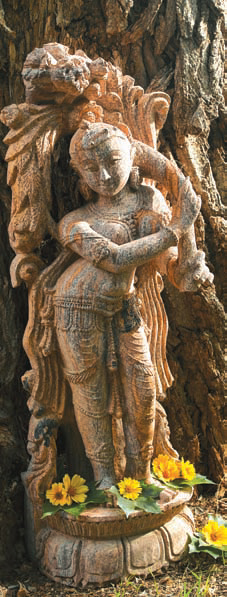
You may have read in some Feng Shui books that abstract art is not a good influence, but this is a misunderstanding. Having beautiful, high-quality abstract art in your home will not weaken it or yourself with amorphous, unfinished qualities. Instead, abstract art can enliven you and your home with uplifting, energizing, peaceful influences of color and subtle vibrational energies.
As an artist myself, I am acutely aware of the effect of art and consider it when creating and when setting my sankalpa, or sacred intention, for the effect and final form of the piece of art. Art should enliven and expand consciousness, energy, joy, and serenity for both the artist and the viewer. Vaastu-appropriate art has an awakening effect upon us, realizing art’s true potential: to enlighten, to wake people up. Swami Muktananda wrote, “The artist must always be responsible for what he brings into the world; he must always paint the highest. As well as acting as receivers of energy, the chakras also transmit energy, as do works of art.”
Image: Yakshi in front of cottonwood tree. Photo: Erika Blumenfeld. Reprinted with permission of Gibbs Smith, Publisher, from Sherri Silverman’s Vastu: Transcendental Home Design in Harmony with Nature.
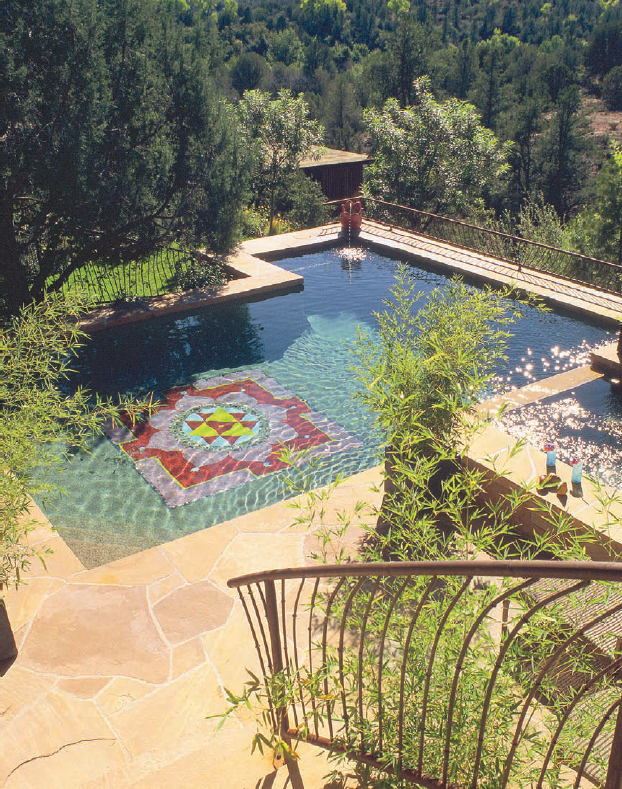
“Through the beauty of material things we come to understand God”
Artwork for a Vaastu home can be in virtually any medium you find appealing. Beautiful photographs of nature uplift and soothe; for citydwellers these photos in additional to live plants and cut flowers bring in that needed connection with nature that is so vital to us. Paintings, drawings, and prints on your walls add color, energy, and decoration to a Vaastu home. Your choice of sculpture should also be included for the rhythmic variety of three-dimensional form in the Vaastu interior design of your home and for pleasing beauty. Sculpture can be of the divine or of any subject matter, abstract or representational, that evokes rasas appropriate in a Vaastu home.
Pool with yantra. Photo: Erika Blumenfeld. Reprinted with permission of Gibbs Smith, Publisher, from Sherri Silverman’s Vastu: Transcendental Home Design in Harmony with Nature.
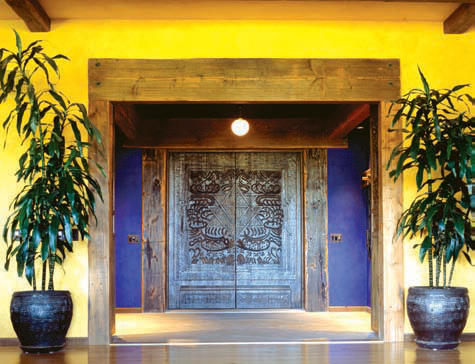
The effect of Vaastu appropriate art on the viewer: art as doorway to peace, silence, and the infinite
There is an inner expansion that takes place within the consciousness of one who experiences an authentic work of art that is in alignment with Vaastu. Art always has the potential to evoke a response in the viewer, and it is this response to art, not just its mere presence on our walls, that is so potent in its effect on our lives. The French poet Mallarme stated, referring to this effect: “Describe not the object itself, but the effect it produces.” When the artist is in contact with the source of creativity, the vitality and expansiveness inherent in his or her work can evoke that deep level of consciousness and expansion in the viewer of the work.
Carved yantra entrance doors. Photo: Erika Blumenfeld. Reprinted with permission of Gibbs Smith,
Publisher, from Sherri Silverman’s Vastu: Transcendental Home Design in Harmony with Nature.
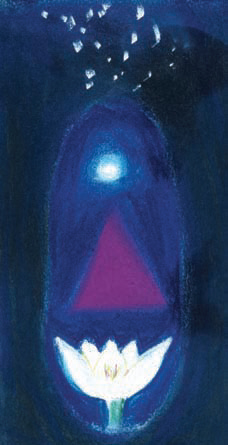
Thus, artists are able to enliven and pass along to their audience that experience of the creative source and flow – to whatever degree the viewer of the work of art is able to be still and silent in order to perceive and respond from within.
Many people experience tranquility from seeing a Vaastu-appropriate sculpture of Buddha or other divine beings. Heinrich Zimmer wrote in Artistic Form and Yoga in the Sacred Images of India about the effect of this three-dimensional art being: “an all-pervasive stillness…, even if there are figures represented as being in great movement. Tranquility radiates from these figures and, settling about the observer, forces him to slow his pace and reduces him to complete silence.”
For people who do spiritual practices (sadhana), more and more experiences like these take place, as this potent transcendental effect radiates into the environment, even if you do not notice it yourself.
Image: Sherri Silverman, Indigo Source, pastel painting.
Contemporary Vaastu appropriate art is healing
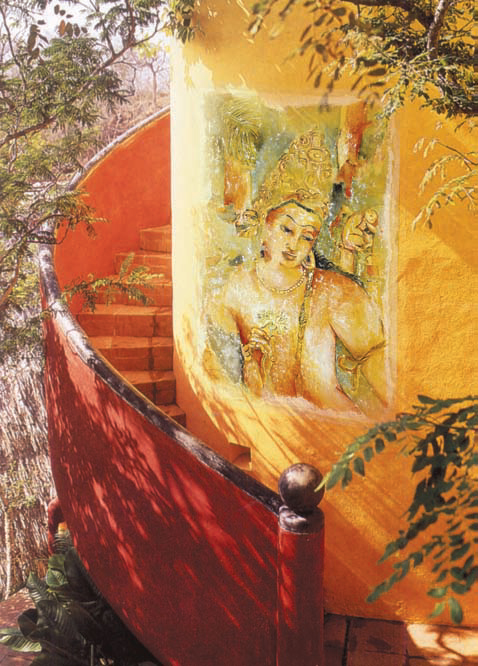 Many contemporary artists have healing in mind when they create, so you should easily be able to find pleasing art for your Vaastu home. Include Vaastu-appropriate artwork in your home that is healing in influence and radiates life-supporting energy both within the home and to the world – a valuable and needed addition to our world in which so many people feel anxious, depressed, and tense that our culture virtually accepts these as normal experiences.
Many contemporary artists have healing in mind when they create, so you should easily be able to find pleasing art for your Vaastu home. Include Vaastu-appropriate artwork in your home that is healing in influence and radiates life-supporting energy both within the home and to the world – a valuable and needed addition to our world in which so many people feel anxious, depressed, and tense that our culture virtually accepts these as normal experiences.
This evocation of the timeless, the infinite, the divine, in order to heal the planet, can be found rather frequently today in the arts and in art criticism. As a Vaastu consultant and visual artist, this is a direction I applaud, include in my own artwork that I create, and see as Vaastu-compliant. Constructing Vaastu buildings, improving existing buildings according to Vaastu guidelines, and installing Vaastu appropriate art in our homes, community buildings, and businesses all help contribute to enhancing our own lives and helping this beautiful planet.
Image: Bodhisattva fresco by Karla Refojo of Indofresco. Photo: Erika Blumenfeld. Reprinted with permission of Gibbs Smith, Publisher, from Sherri Silverman’s Vastu: Transcendental Home Design in Harmony with Nature.
 Sherri Silverman, Ph.D., is an artist, writer, speaker, art consultant and Vaastu design consultant (www.transcendencedesign.com) who has worked with hundreds of clients in the U.S. and internationally. Sherri taught meditation, yoga, healing breath techniques, and sacred text courses from the Vedic tradition for over thirty years and studied directly with spiritual teachers Maharishi Mahesh Yogi and Sri Sri Ravi Shankar. She was adjunct professor of art history, creativity, and interdisciplinary studies at several universities. As a visual artist, Sherri has shown in galleries and museums since 1980; her artwork is in numerous public and private collections, including the New Mexico Capitol Art Collection. She is also the author of Vastu: Transcendental Home Design in Harmony with Nature. She lives in Santa Fe.
Sherri Silverman, Ph.D., is an artist, writer, speaker, art consultant and Vaastu design consultant (www.transcendencedesign.com) who has worked with hundreds of clients in the U.S. and internationally. Sherri taught meditation, yoga, healing breath techniques, and sacred text courses from the Vedic tradition for over thirty years and studied directly with spiritual teachers Maharishi Mahesh Yogi and Sri Sri Ravi Shankar. She was adjunct professor of art history, creativity, and interdisciplinary studies at several universities. As a visual artist, Sherri has shown in galleries and museums since 1980; her artwork is in numerous public and private collections, including the New Mexico Capitol Art Collection. She is also the author of Vastu: Transcendental Home Design in Harmony with Nature. She lives in Santa Fe.

